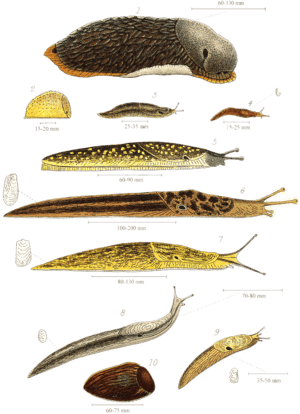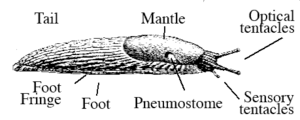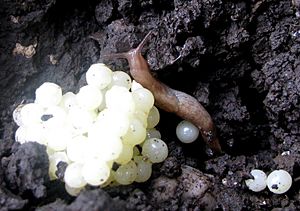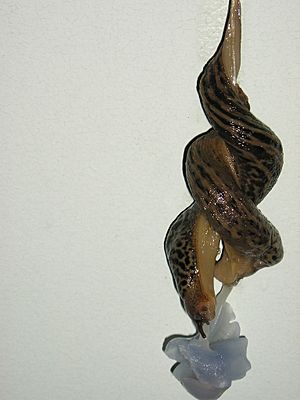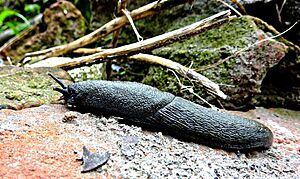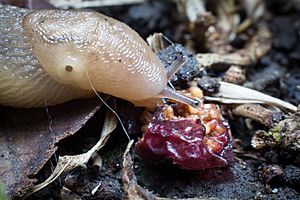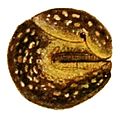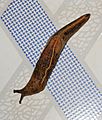Slug facts for kids
A slug is a type of mollusc called a gastropod. It's like a snail, but it either has no shell or only a very small shell hidden inside its body.
Slugs belong to many different families. Some of these families also include snails with shells. Snails are gastropods that have a big, coiled shell they can hide inside. Even though land slugs look alike, the families they belong to are not very closely related. Slugs look similar because they evolved in similar ways. This means the word "slug" is not a scientific group name.
The word "slug" usually refers to land slugs that breathe air. Slugs found in the ocean are called sea slugs. Sometimes, land gastropods with a shell too small to hide their body are called semislugs.
Contents
Description
Here are the main parts you can see on a slug:
Tentacles Most land slugs have two pairs of 'feelers' on their head, just like other land snails that breathe air. The top pair helps them see, with small eyes at the tips. The bottom pair helps them smell. Both pairs can pull back into the slug's head.
Mantle Behind the slug's head, on its back, is a part shaped like a saddle. This is called the mantle. Under the mantle are the slug's breathing hole, its reproductive opening, and its anus. The breathing hole, called the pneumostome, is usually on the right side. It's easy to see when open but hard to spot when closed.
Tail The part of the slug behind its mantle is called the 'tail'.
Keel Some slugs, like the Tandonia budapestensis, have a raised line along the middle of their back. This line is called a 'keel'. It can run along the whole tail or just part of it.
Foot The flat bottom part of a slug is called the 'foot'. Slugs move by making waves of muscle contractions on their foot. As they move, they also make a layer of mucus (slime). This slime helps them glide and protects their foot. Some slugs have a 'foot fringe' around the edge of their foot.
Hidden Shell Most slugs still have a small part of a shell, but it's usually inside their body. This hidden shell stores calcium and helps with digestion. Slugs like those in the Limacidae family have an internal shell. However, adult Philomycidae, Onchidiidae, and Veronicellidae slugs do not have shells at all.
Physiology
Slugs are mostly made of water. Since they don't have a big shell, their soft bodies can dry out easily. To survive, they must make a lot of protective mucus. Many slugs are most active right after it rains because the ground is wet. When it's dry, they hide in damp places. They might hide under tree bark, fallen logs, rocks, or even planters. This helps them keep their bodies moist.
Like all gastropods, slugs' internal organs twist 180 degrees as they grow. Inside, you can see this twisting. But on the outside, slugs look mostly the same on both sides, except for their breathing hole. This hole is usually on the right side of their body.
Slugs make two kinds of mucus: one is thin and watery, and the other is thick and sticky. Both types absorb water. The thin mucus spreads from the middle of the foot to its edges. The thick mucus spreads from front to back. Slugs also make thick mucus that covers their whole body. The slime from their foot has fibers that help them stick to and climb vertical surfaces.
The "slime trail" a slug leaves behind is useful. Other slugs can tell if the trail was made by one of their own kind. This helps them find a mate. Some slugs that eat other animals also follow slime trails to hunt. The body mucus also protects slugs from animals that want to eat them. It makes the slug hard for a bird to pick up. The mucus can also taste bad. Some slugs, like Limax maximus, even use slime cords to hang during mating.
Reproduction
Slugs are hermaphrodites. This means each slug has both male and female reproductive parts. When two slugs find each other, they often circle around and exchange sperm. A few days later, the slugs lay about thirty eggs. They usually lay them in a hole in the ground or under something like a fallen log.
Only some types of banana slugs (Ariolimax) and one type of Deroceras use their male parts when mating. However, they can also mate using only their female parts.
Ecology
Slugs are important in the ecosystem. They help by eating dead plants and fungi. Most slugs that eat other animals will also sometimes eat dead slugs of their own kind.
Feeding habits
Most slugs eat many different things. They eat leaves from living plants, lichens, mushrooms, and even dead animals. Some slugs are predators. They eat other slugs, snails, or earthworms.
Slugs can eat many kinds of vegetables and herbs. This includes flowers like petunias, chrysanthemums, daisies, lobelia, lilies, and daffodils. They also eat fruits like strawberries. They will also eat carrots, peas, apples, and cabbage if that's all they can find.
Some slugs eat only fungi. For example, Philomycidae slugs eat slime molds. Ariolimax californianus slugs eat mushrooms. Slugs might eat specific parts of fungi or only fungi at certain stages of growth. But sometimes, they eat whole mushrooms without being picky.
Predators
Many different animals eat slugs. These include both vertebrates (animals with backbones) and invertebrates (animals without backbones). Slugs can be a problem for farmers because they eat crops. Because of this, people have studied what animals eat slugs. This helps them find ways to control slug populations naturally.
Images for kids
-
The alarm posture of the Kerry slug
-
A banana slug eating a fly agaric mushroom
See also
 In Spanish: Babosa para niños
In Spanish: Babosa para niños


